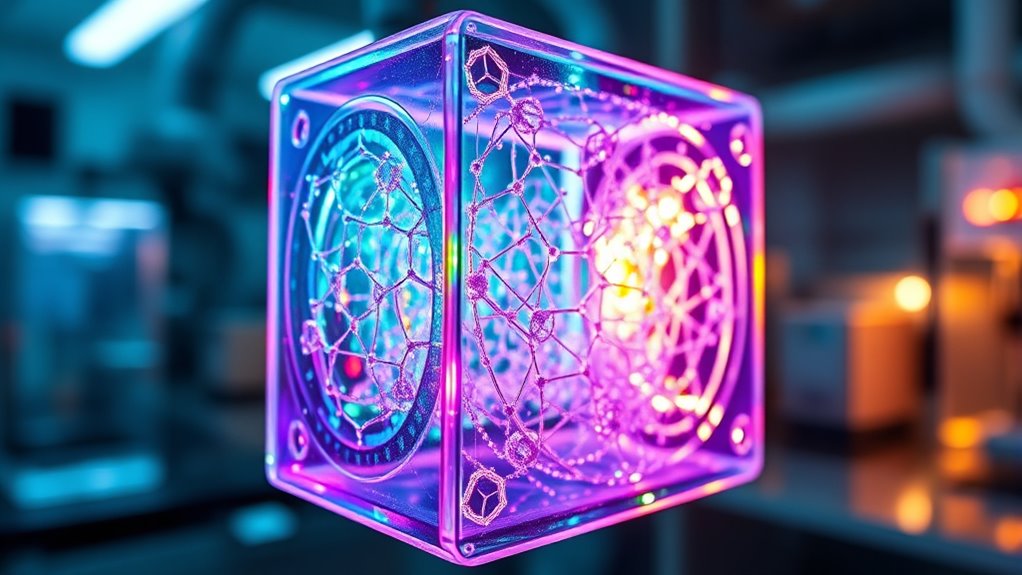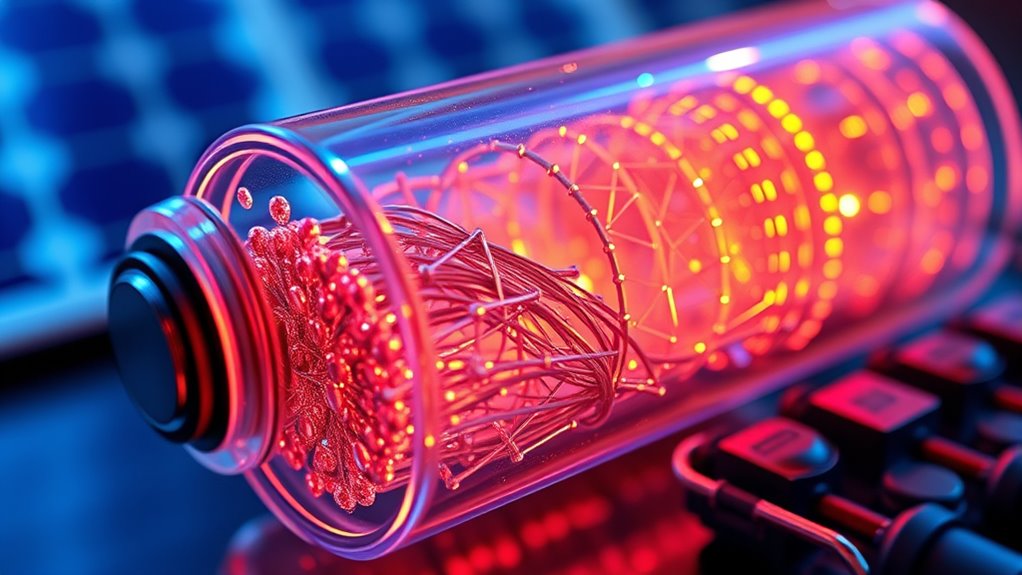Energy nanomaterials enhance batteries, fuel cells, and solar cells by improving efficiency, durability, and environmental sustainability. Nano-structured materials increase surface area, speeding up charge/discharge cycles and boosting energy storage. Nanoscale catalysts make fuel cells more efficient and cost-effective, while nanowires and quantum dots improve solar absorption and light management. If you’re curious about how these innovations are shaping clean energy, you’ll discover more exciting details as you explore further.
Key Takeaways
- Nanomaterials like nanowires, nanotubes, and quantum dots enhance energy storage and conversion efficiency in batteries, fuel cells, and solar cells.
- Nanoscale catalysts improve reaction rates, durability, and reduce costs for fuel cell and solar fuel applications.
- Nanostructured solar cells leverage quantum dots and nanowires to increase light absorption and photovoltaic efficiency.
- Incorporating nanotechnology addresses challenges like dendrite formation, corrosion, and charge recombination in energy devices.
- Sustainable management of nanomaterials involves responsible disposal, recycling, and development of eco-friendly nanostructures.
Advancements in Nanomaterials for Battery Technology

Recent advancements in nanomaterials have markedly transformed battery technology by enhancing performance, stability, and energy density. You’ll notice that nanostructured materials, such as nanoscale electrodes and conductive nanomaterials, improve charge transport and reduce degradation over time. These tiny materials increase the surface area, enabling batteries to store more energy and charge faster. Additionally, nanomaterials help mitigate issues like dendrite formation, which can cause short circuits and safety hazards. You’ll find that incorporating nanotechnology into battery components leads to lighter, more efficient devices with longer lifespans. Researchers are also developing novel nanostructures, such as nanowires and nanotubes, that further optimize performance. Moreover, understanding the color accuracy of materials used in nanotechnology can lead to improved visualization and diagnostics in nanodevices. This progress in nanomaterials is vital for advancing portable electronics, electric vehicles, and renewable energy storage systems.
Enhancing Fuel Cell Performance With Nanoscale Innovations

Nanoscale innovations can substantially boost fuel cell performance by increasing catalyst efficiency and reducing material costs. You’ll find that designing durable nanostructures helps extend the lifespan and stability of fuel cells. These advancements are key to making clean energy solutions more practical and reliable. Incorporating wall organization systems into fuel cell design can further optimize the arrangement of components for improved functionality.
Nanoscale Catalyst Efficiency
Have you ever wondered how tiny changes at the atomic level can boost fuel cell performance? Nanoscale catalysts dramatically improve efficiency by increasing surface area and active sites. Here’s how:
- They reduce catalyst particle size, allowing more contact points for reactions.
- They enable better electron transfer, decreasing energy loss.
- They facilitate faster reaction kinetics, boosting overall power output.
Using nanomaterials like platinum nanoparticles, you can maximize catalytic activity while minimizing material use. This not only lowers costs but also enhances durability since smaller particles are more uniformly distributed. The increased surface area means more active sites are available, speeding up reactions and improving fuel cell efficiency. Additionally, material stability is improved when catalysts are engineered at the nanoscale, helping to extend the lifespan of fuel cells. By manipulating catalysts at the nanoscale, you optimize performance without sacrificing stability, making fuel cells more practical and powerful for real-world applications.
Improved Durability Strategies
To guarantee fuel cells operate reliably over time, researchers are developing nanoscale strategies that enhance durability. One approach involves designing nanostructured electrodes that resist degradation caused by repeated cycling. By optimizing the size, shape, and composition of nanoscale materials, you can reduce mechanical stress and prevent catalyst dissolution. Additionally, incorporating protective coatings at the nanoscale helps inhibit corrosion and chemical wear. Researchers also explore self-healing nanomaterials that repair damage during operation, extending lifespan. Using durable nanostructures minimizes performance loss and ensures consistent energy output. Self-awareness in the design process can lead to more adaptive and resilient nanomaterials. These innovations not only improve fuel cell longevity but also make them more practical for real-world applications, ultimately bringing cleaner energy solutions closer to everyday use.
Nanostructured Solar Cells and Photovoltaic Efficiency

Nanostructured solar cells have revolutionized photovoltaic technology by enhancing light absorption and charge transport. Their unique designs allow for better interaction with sunlight, increasing efficiency. Here are three key benefits:
- Increased Surface Area: Nanostructures like quantum dots and nanowires capture more sunlight, boosting energy conversion.
- Reduced Recombination: Smaller features shorten charge travel paths, minimizing energy loss and improving power output.
- Tunable Properties: You can customize nanomaterials to optimize absorption spectra, making cells more effective across different wavelengths.
Additionally, the integration of natural materials and sustainable design principles in nanomaterials contributes to environmentally friendly energy solutions. These advancements lead to higher efficiencies and more cost-effective solar panels. By manipulating nanostructures, you improve light management and charge dynamics, pushing solar technology toward greater competitiveness and sustainability. This evolution in design helps harness solar energy more effectively than ever before.
The Role of Nanotechnology in Energy Storage Solutions

Nanotechnology is transforming energy storage solutions by enabling the development of materials with enhanced capacity, durability, and charge-discharge rates. You’ll find nanomaterials like nanotubes, nanowires, and nanoporous structures that increase surface area, allowing batteries and supercapacitors to store more energy efficiently. These materials also improve ion transport, leading to faster charging and discharging cycles. By incorporating nanostructures into electrode and electrolyte designs, you can achieve greater stability and longer lifespan for energy storage devices. This innovation reduces weight and size, making energy storage systems more portable and adaptable for various applications. Overall, nanotechnology provides you with more reliable, high-performance solutions that meet the growing demand for efficient energy management across multiple sectors.
Challenges and Future Directions in Energy Nanomaterials

Despite the remarkable potential of energy nanomaterials, several challenges hinder their widespread adoption. You face issues like stability, scalability, and cost. First, nanomaterials often degrade over time, reducing device lifespan and efficiency. Second, scaling up production while maintaining quality remains difficult and expensive. Third, high manufacturing costs limit commercial viability, especially for large-scale applications. Overcoming these barriers requires advances in synthesis methods, better understanding of long-term stability, and cost-effective manufacturing processes. Additionally, integrating nanomaterials into existing energy systems demands compatibility and standardization. Future research should focus on improving durability, developing scalable fabrication techniques, and reducing costs. Furthermore, addressing the challenges of manufacturing costs and scalability will be key to access the full potential of energy nanomaterials in sustainable energy solutions.
Environmental Impact and Sustainability of Nanotech Energy Devices

As energy nanomaterials become more prevalent in sustainable energy solutions, understanding their environmental impact is essential. You need to consider how these materials are mined, manufactured, and disposed of, as nanomaterials can pose risks to ecosystems and human health. During production, you should minimize toxic emissions and waste, ensuring eco-friendly practices. When used, nanotech devices may release nanoparticles into the environment, so it’s imperative to assess potential contamination. Recycling and end-of-life management are critical to prevent accumulation of nanomaterials in landfills and water systems. By prioritizing sustainable sourcing, safe manufacturing, and responsible disposal, you can help reduce negative impacts and promote the long-term viability of nanotech energy devices. This approach guarantees that advancements in energy technology align with environmental stewardship. Incorporating antioxidant-rich materials into manufacturing processes can further mitigate environmental risks associated with nanomaterials.
Emerging Trends and Breakthroughs in Renewable Energy Nanomaterials

Recent advances in renewable energy nanomaterials are driving rapid innovation, leading to more efficient and cost-effective solutions. You’ll find exciting breakthroughs that are transforming the landscape.
Here are three key trends:
- Enhanced Solar Cells: Researchers are developing nanostructured materials like perovskite nanocrystals that boost light absorption and conversion efficiency.
- Next-Gen Catalysts: Nanomaterials such as platinum and cobalt nanoparticles are improving the performance of water-splitting and fuel cell catalysts, reducing costs.
- Flexible and Lightweight Devices: Innovations in nanomaterials enable the creation of flexible solar panels and energy storage systems, expanding application possibilities.
- Emphasizing active listening and empathy in the development of nanomaterial technologies can facilitate better collaboration and innovation in renewable energy research.
These trends are accelerating renewable energy adoption, making clean energy more accessible and sustainable for everyone.
Frequently Asked Questions
How Do Nanomaterials Influence the Lifespan of Energy Devices?
Nanomaterials extend the lifespan of energy devices by enhancing their durability and stability. You’ll notice improved resistance to wear, degradation, and thermal stress because nanomaterials strengthen electrode structures and protect against corrosion. Their unique properties enable devices to operate efficiently over longer periods, reducing the need for frequent replacements. As a result, your energy devices become more reliable, cost-effective, and environmentally friendly, thanks to the innovative role of nanomaterials.
What Safety Concerns Exist With Nanomaterial-Based Energy Systems?
You should be aware that nanomaterial-based energy systems pose safety concerns like potential toxicity and environmental impact. Fine nanoparticles can become airborne, leading to inhalation risks or skin exposure. They may also cause unforeseen reactions or degradation over time. To stay safe, always follow proper handling procedures, use protective gear, and guarantee proper disposal. Ongoing research aims to minimize these risks and develop safer nanotech energy solutions.
Can Nanotech Improve the Cost-Effectiveness of Renewable Energy?
Yes, nanotech can make renewable energy more cost-effective. By improving the efficiency of solar panels and batteries, nanomaterials help you generate and store energy more effectively, reducing costs over time. They also enable lighter, more durable components, cutting manufacturing and maintenance expenses. With nanotech, you can access cleaner energy at a lower price, making renewable options more practical and attractive for widespread use.
How Scalable Are Nanomaterial Manufacturing Processes for Energy Applications?
You can scale nanomaterial manufacturing for energy applications, but challenges remain. Techniques like chemical vapor deposition and solution-based processes are advancing rapidly, enabling larger production volumes. However, maintaining quality and consistency at industrial scales requires ongoing research and investment. With continued innovation, you’ll find that scalable nanomanufacturing becomes more feasible, reducing costs and boosting the deployment of nanotech-enabled energy solutions worldwide.
Are There Any Health Risks Associated With Nanomaterials in Energy Devices?
You should be aware that nanomaterials in energy devices can pose health risks, especially if particles become airborne during manufacturing or disposal. For example, inhaling fine nanoparticles has been linked to respiratory issues in lab studies. While safety protocols help, you need to handle these materials with proper protective equipment and disposal methods to minimize exposure, as long-term effects are still being researched.
Conclusion
You might be surprised to learn that nanomaterials can boost solar cell efficiency by over 30%, transforming renewable energy. As you explore these innovations, you’ll see how nanotech is revolutionizing batteries, fuel cells, and solar devices, making energy storage cleaner and more sustainable. The future of energy depends on these tiny materials, offering solutions to global challenges. Stay excited—these breakthroughs could power your world more efficiently and eco-friendly than ever before.









